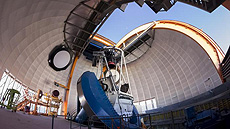Astronomers give Dark Energy Camera rave reviews
 |
Even before the Dark Energy Survey begins, the Dark Energy Camera is exceeding expectations in the astrophysics community. Photo: Anja von der Linden
|
Astronomer Daniel Kelson is part of a team working to answer an intriguing question about our universe: Why are fewer and fewer stars being created over time? He's been collecting data for years, but one piece of the puzzle eluded him.
That is, until December of last year, when he spent two nights in Chile observing the sky with the new Dark Energy Camera. Kelson came away from his observing session with the information he needed to complete his research, and with a healthy dose of respect for what he calls the "super camera," installed at the southern hemisphere station of the US National Optical Astronomy Observatory.
"It was beautiful to use," Kelson says. "It's impressive that the various teams could come together and make such a phenomenal camera."
He's not alone in his appreciation.
The 570-megapixel Dark Energy Camera—the world's most powerful digital imaging device, built at Fermilab and installed on the Blanco 4-meter telescope at the Cerro Tololo Inter-American Observatory in Chile—was constructed for the Dark Energy Survey, a five-year effort to map a portion of the southern sky in unprecedented detail. Since the camera was turned on in November, the DES has spent 50 nights completing the science verification phase of the experiment.
When DES members are not operating the camera, it's available for other astronomers like Kelson to use. Since last December, 19 other groups of scientists from institutions including Harvard, the University of Virginia and the University of California at Berkeley have signed up for nights with the Dark Energy Camera. Some teams searched for asteroids while some examined the properties of galaxies.
Read more
—Andre Salles
|